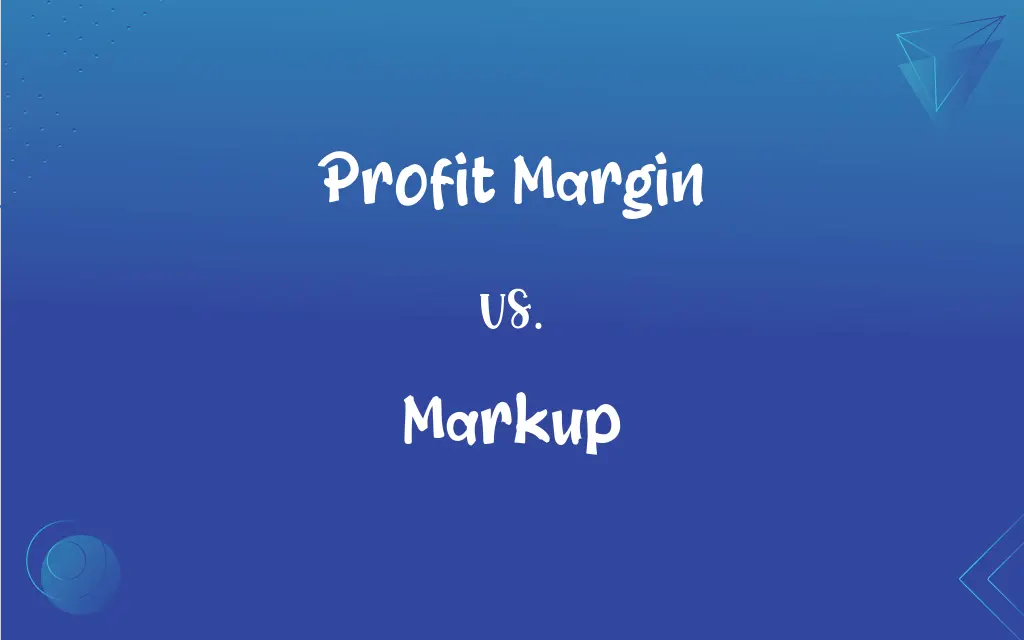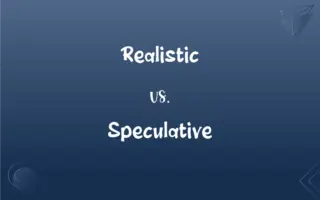Profit Margin vs. Markup: What's the Difference?
Edited by Aimie Carlson || By Harlon Moss || Published on November 20, 2023
Profit margin is the percentage of revenue that exceeds the cost of goods sold; markup is the percentage added to the cost of a product to determine its selling price.

Key Differences
Profit margin represents the portion of sales revenue that exceeds the cost of goods sold. It provides insights into how much of the revenue is actual profit after accounting for the cost. Markup, on the other hand, is the percentage added to the cost of a product to establish its selling price.
Profit margin essentially measures the profitability of a sale. It tells a business how much of every dollar in sales is profit. Markup, conversely, measures how much more a business sells a product for than what it cost to produce or purchase.
When businesses evaluate their profitability, they often look at the profit margin. It provides a clear picture of the company's overall financial health. Markup, meanwhile, is more commonly used when setting product prices, ensuring there's a buffer to cover overhead costs and profit.
A high profit margin indicates a very profitable business model, where a significant portion of revenue turns into profit. Markup, on the other hand, is a tool used primarily by retailers or wholesalers to ensure they achieve a certain profit margin once the product is sold.
A business might have a high markup but a low profit margin if it has significant overhead or other expenses. Conversely, another might have a low markup but high profit margin if its costs are extremely low.
ADVERTISEMENT
Comparison Chart
Definition
Percentage of revenue over cost of goods sold.
Percentage added to the cost to set selling price.
Application
Used to evaluate profitability.
Used in price determination.
Calculation
(Net Profit / Revenue) x 100
(Selling Price - Cost) / Cost x 100
Business Implication
Reflects the company's financial health.
Helps achieve a certain profit once sold.
Dependency
Depends on revenue and costs.
Primarily depends on the cost of a product.
ADVERTISEMENT
Profit Margin and Markup Definitions
Profit Margin
The percentage that represents how much of every sale is profit.
If a company earns $150 in profit from a $750 sale, the profit margin is 20%.
Markup
The amount added to the cost of a product to determine its selling price.
If a product costs $10 to make and has a markup of 50%, it's sold for $15.
Profit Margin
A measure indicating the profitability of a sale.
A high profit margin shows that the business retains a good portion of sales as profit.
Markup
The difference between the cost of producing a product and its sale price.
A $20 item with a $10 markup will be sold for $30.
Profit Margin
The ratio of net profit to revenue expressed as a percentage.
The company has a profit margin of 20%, indicating 20 cents of every dollar is profit.
Markup
The value increase of a product or service over its base cost.
If a wholesaler buys a toy for $5 and applies a $3 markup, the selling price is $8.
Profit Margin
The difference between sales revenue and the cost to produce or purchase goods.
If it costs $50 to make a product and it sells for $100, the profit margin is 50%.
Markup
A percentage used by retailers to cover overhead costs and achieve profit.
A retailer might apply a 40% markup to ensure all costs are covered and profits are made.
Profit Margin
The portion of sales that exceeds the cost of goods sold.
With revenues of $1000 and costs of $800, the profit margin is $200.
Markup
The ratio between the difference of a product's cost and its sale price, to its cost.
A dress that costs $50 with a markup of 20% is sold for $60.
Markup
A raise in the price of an item for sale.
Markup
An amount added to a cost price in calculating a selling price, especially an amount that takes into account overhead and profit.
Markup
A session of a US congressional committee at which a legislative bill is put into final form.
Markup
The collection of detailed stylistic instructions written on a manuscript that is to be typeset.
FAQs
How can I increase my profit margin?
By increasing revenue, reducing costs, or both.
Can a company have a high markup but low profit margin?
Yes, if it has high overhead or other expenses.
How is profit margin different from markup?
Profit margin shows profitability from revenue, while markup shows how much is added to the cost to determine the selling price.
Is a higher markup always better for a business?
Not necessarily; a higher markup can deter customers if prices become uncompetitive.
Why is markup crucial for retailers?
Markup ensures that retailers cover costs and make a profit.
Can two products have the same markup but different profit margins?
Yes, if their costs or selling prices vary.
Is it possible for a company to have a positive markup but a negative profit margin?
Yes, if the company's other expenses exceed its revenue.
What is profit margin in simple terms?
Profit margin is the percentage of revenue that exceeds the cost of goods sold.
How can I determine the right markup for my product?
Consider the cost of the product, desired profit margin, competition, and market conditions.
Which is more important: profit margin or markup?
Both are essential; profit margin evaluates overall profitability, while markup helps set product prices.
Do all industries have the same average profit margins?
No, average profit margins can vary widely between industries.
Why might a company choose a lower markup?
To be competitive, increase sales volume, or penetrate a new market.
What's the relationship between selling price, cost, and markup?
Selling price equals the cost plus the markup.
Is profit margin always a better indicator of financial health than markup?
Not always; both metrics provide different insights and are essential in their contexts.
Are profit margin and markup used interchangeably?
No, they have distinct definitions and applications in business.
Is profit margin the same as net profit?
No, profit margin is a percentage, while net profit is an absolute dollar amount.
What happens if markup is too low?
The business might not cover its costs or make a profit.
If a product costs $5 and is sold for $10, what's the markup?
The markup is 100%.
Why might two companies in the same industry have different profit margins?
Differences in operational efficiency, costs, or pricing strategies can lead to varied profit margins.
Can a product have a 0% profit margin?
Yes, if the revenue from the product equals its costs.
About Author
Written by
Harlon MossHarlon is a seasoned quality moderator and accomplished content writer for Difference Wiki. An alumnus of the prestigious University of California, he earned his degree in Computer Science. Leveraging his academic background, Harlon brings a meticulous and informed perspective to his work, ensuring content accuracy and excellence.
Edited by
Aimie CarlsonAimie Carlson, holding a master's degree in English literature, is a fervent English language enthusiast. She lends her writing talents to Difference Wiki, a prominent website that specializes in comparisons, offering readers insightful analyses that both captivate and inform.






































































